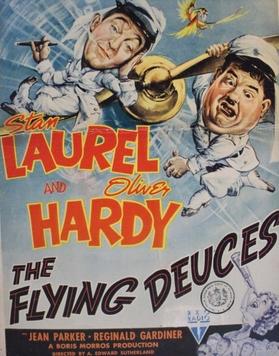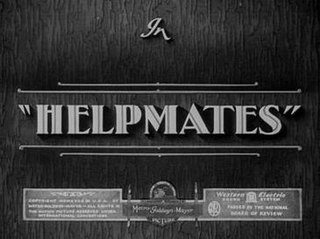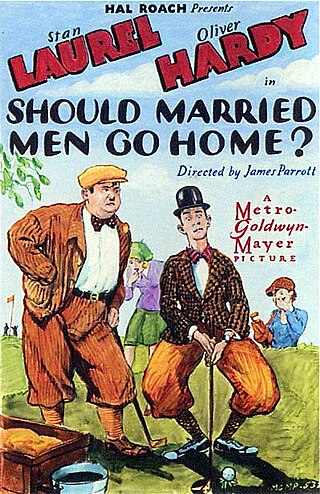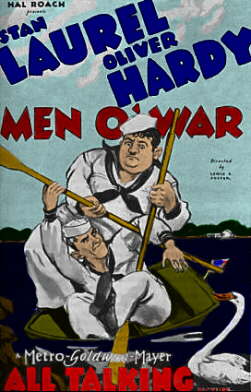
Laurel and Hardy were a British-American comedy team during the early Classical Hollywood era of American cinema, consisting of Englishman Stan Laurel (1890–1965) and American Oliver Hardy (1892–1957). Starting their career as a duo in the silent film era, they later successfully transitioned to "talkies". From the late 1920s to the mid-1950s, they were internationally famous for their slapstick comedy, with Laurel playing the clumsy, childlike friend to Hardy's pompous bully. Their signature theme song, known as "The Cuckoo Song", "Ku-Ku", or "The Dance of the Cuckoos" was heard over their films' opening credits, and became as emblematic of them as their bowler hats.

The Rogue Song is a 1930 American pre-Code romantic and musical film that tells the story of a Russian bandit who falls in love with a princess, but takes his revenge on her when her brother rapes and kills his sister. The Metro-Goldwyn-Mayer production was directed by Lionel Barrymore and released in two versions, with and without sound. Hal Roach wrote and directed the Laurel and Hardy sequences and was not credited. The film stars Metropolitan Opera singer Lawrence Tibbett—who was nominated for an Academy Award for Best Actor for his performance—and Catherine Dale Owen. Laurel and Hardy were third-billed; their sequences were filmed at the last minute and interspersed throughout the film in an attempt to boost its potential box-office appeal.

Sons of the Desert is a 1933 American pre-Code comedy film starring Laurel and Hardy. Directed by William A. Seiter, it was released in the United States on December 29, 1933. In the United Kingdom, the film was originally released under the title Fraternally Yours.

Babes in Toyland is a Laurel and Hardy musical Christmas film released on November 30, 1934. The film is also known by the alternative titles Laurel and Hardy in Toyland, Revenge Is Sweet, and March of the Wooden Soldiers, a 73-minute abridged version.

Big Business is a 1929 silent Laurel and Hardy comedy short subject directed by James W. Horne and supervised by Leo McCarey from a McCarey (uncredited) and H. M. Walker script. The film, largely about tit-for-tat vandalism between Laurel and Hardy as Christmas tree salesmen and the man who rejects them, was deemed culturally significant and entered into the National Film Registry in 1992.

We Faw Down is a synchronized sound short subject film directed by Leo McCarey starring comedy duo Laurel and Hardy. It was released by Metro-Goldwyn-Mayer on December 29, 1928. While the film has no audible dialog, it was released with a synchronized orchestral musical score with sound effects. It was remade in part with their film Sons of the Desert in 1933.

A Chump at Oxford is a Hal Roach comedy film produced in 1939 and released in 1940 by United Artists. It was directed by Alfred J. Goulding and is the penultimate Laurel and Hardy film made at the Roach studio. The title echoes the film A Yank at Oxford (1938), of which it is a partial parody.

The Flying Deuces, also known as Flying Aces, is a 1939 buddy comedy film starring Laurel and Hardy, in which the duo join the French Foreign Legion. It is a partial remake of their short film Beau Hunks (1931).

Helpmates is a Laurel and Hardy Pre-Code short film comedy. It was directed by James Parrott, produced by Hal Roach and released by Metro-Goldwyn Mayer on January 23, 1932.

Hats Off is a lost silent short film starring Laurel and Hardy. The team appeared in a total of 107 films between 1921 and 1951.

Chickens Come Home is a 1931 American pre-Code short film starring Laurel and Hardy, directed by James W. Horne and produced by Hal Roach. It was shot in January 1931 and released on February 21, 1931. It is a remake of the 1927 silent film Love 'em and Weep in which James Finlayson plays Hardy's role and Hardy plays a party guest.

The Battle of the Century is a 1927 silent short film starring comedy double act Laurel and Hardy, who appeared in 107 films between 1921 and 1951. The film entered the public domain in the United States in 2023.

Should Married Men Go Home? is a silent short subject co-directed by Leo McCarey and James Parrott, starring comedy duo Laurel and Hardy. It was the first Hal Roach film to bill Laurel and Hardy as a team. Previous appearances together were billed under the Roach "All-Star Comedy" banner. It was released by Metro-Goldwyn-Mayer on September 8, 1928. McCarey is also one of the script writers for the film.

Men O' War is the third sound film starring Laurel and Hardy, released on June 29, 1929.

The Bullfighters is a feature film starring comedy duo Laurel and Hardy, the sixth and final film the duo made under 20th Century Fox as well as the last released in the United States.

The Laurel-Hardy Murder Case is a Laurel and Hardy pre-Code comedy horror film released in 1930. It is one of a handful of three-reel comedies they made, running 28 minutes. It was directed by James Parrott, produced by Hal Roach and distributed by Metro-Goldwyn-Mayer.

Blotto is a 1930 American pre-Code comedy film directed by James Parrott and starring Stan Laurel and Oliver Hardy. The short was produced by Hal Roach and originally distributed by Metro-Goldwyn-Mayer.

Swiss Miss is a 1938 comedy film starring Laurel and Hardy. It was directed by John G. Blystone, and produced by Hal Roach. The film features Walter Woolf King, Della Lind and Eric Blore.

Laughing Gravy is a 1931 short film comedy starring Laurel and Hardy. It was directed by James W. Horne, produced by Hal Roach and distributed by Metro-Goldwyn-Mayer.

The Live Ghost is a 1934 American comedy short film starring Laurel and Hardy, directed by Charles Rogers, and produced by Hal Roach at his studios in Culver City, California.




















